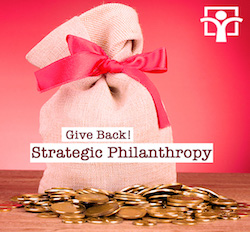
Addressing Philanthropy Goals Before Year-End
In the height of charitable giving season, a review of recent tax changes provides an opportunity for advisors and clients to plan more strategically, while maximizing tax savings and planning 2019 investments before year-end. Here’s a checklist of talking points for your December meetings:
 Tax Reforms.The big change for 2018 was the elimination of the First Time Donor’s Super Credit, and the announcement of media-related tax relief proposed in the Fall Economic Update.
Tax Reforms.The big change for 2018 was the elimination of the First Time Donor’s Super Credit, and the announcement of media-related tax relief proposed in the Fall Economic Update.
Donations up to $200. For those who donate smaller amounts, the credit for the first $200 donated is calculated at a federal rate of 15%; so a donation of, say, $100 earns you a non-refundable credit of $15.00, plus the provincial/territorial equivalent credit which ranges from $4.00 in Nunavut to $10.80 in Manitoba. Spouses should be sure to combine donations individually made on one return, to get over the $200 threshold.
Donations by Mid-Income Earners. If your income is below the high-income threshold to which a 33% federal tax rate applies (less than $205,842 in 2018), you’ll receive a federal credit calculated at 29% for the amount of your donation that exceeds $200. For example, a donation of $1,000 would earn you a non-refundable federal tax credit of 15% x $200 + 29% x $800 = $262. An additional provincial/territorial credit applies, ranging from 11.5 percent in Nunavut to 21 percent in Alberta and Nova Scotia.
Donations by High-Income Earners. However, if some of your taxable income is taxed at 33% (i.e., your taxable income exceeds $205,842 in 2018), you’ll get a credit for the lesser of 33% of the amount of income taxed at 33%, and the amount of your donations less $200. (Yes, it’s tricky!) The remaining amount of your donation would be eligible for the credit at 29%. The same provincial/territorial credits apply to high-income earners as to mid-income earners.
Knowledge Bureau, in partnership with CAGP and Spire Philanthropy, will be offering more opportunities to help tax and financial advisors brush up on their strategic philanthropy strategies in 2019. The MFA – Philanthropy designation launches online in January 2019, and provides the following knowledge through its course components:
Introduction to Strategic Philanthropy
- Why Families Give - Emerging Philanthropic Trends
- The Role of the Advisor
- Ways to Give - Tax Aspects of Charitable Giving
- Current Gifts - Tax Implications
- Deferred Gifts - Tax Implications
- What a Successful Plan Looks Like
Matching Charitable Sector Options with Client Profiles
- Understanding the Charitable Sector
- Gifting Structures
- Gift Planning Strategies for Young Families
- Gift Planning Strategies for HNW Families
- Gift Planning Strategies for Business Owners
- Gift Planning with Substitute Decision-Makers - POAs and Executors
Successful Planning: Case Studies in Strategy Execution
- Tips and Traps in Planning with Individuals and HNW Families
- Tips and Traps in Planning with Business Owners
- Tips and Traps in Planning with Singles and Survivors
Pre-register before December 15 for tuition savings!
COPYRIGHT OWNED BY KNOWLEDGE BUREAU INC., 2018.
UNAUTHORIZED REPRODUCTION, IN WHOLE OR IN PART, IS PROHIBITED.





